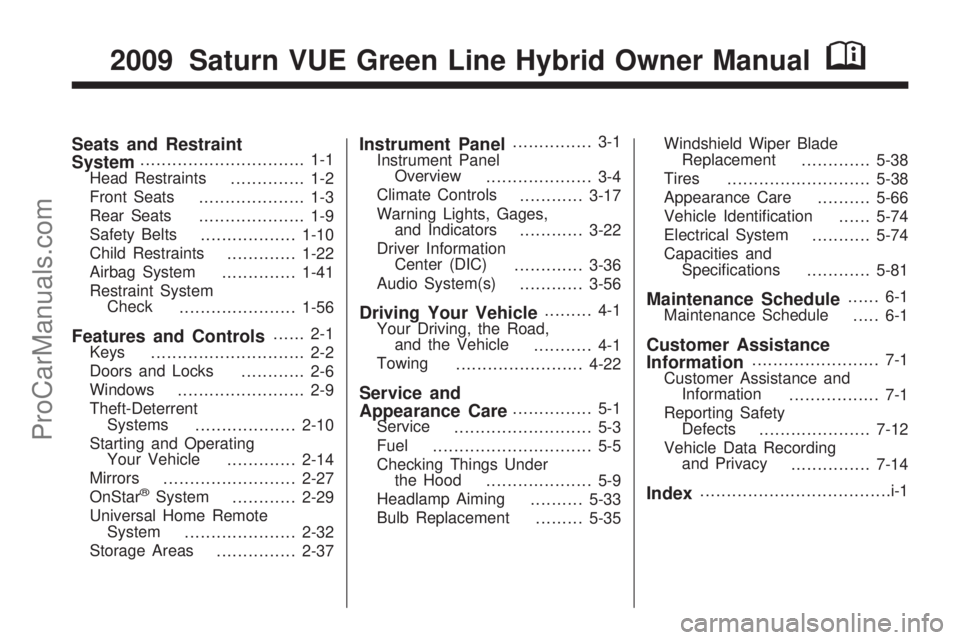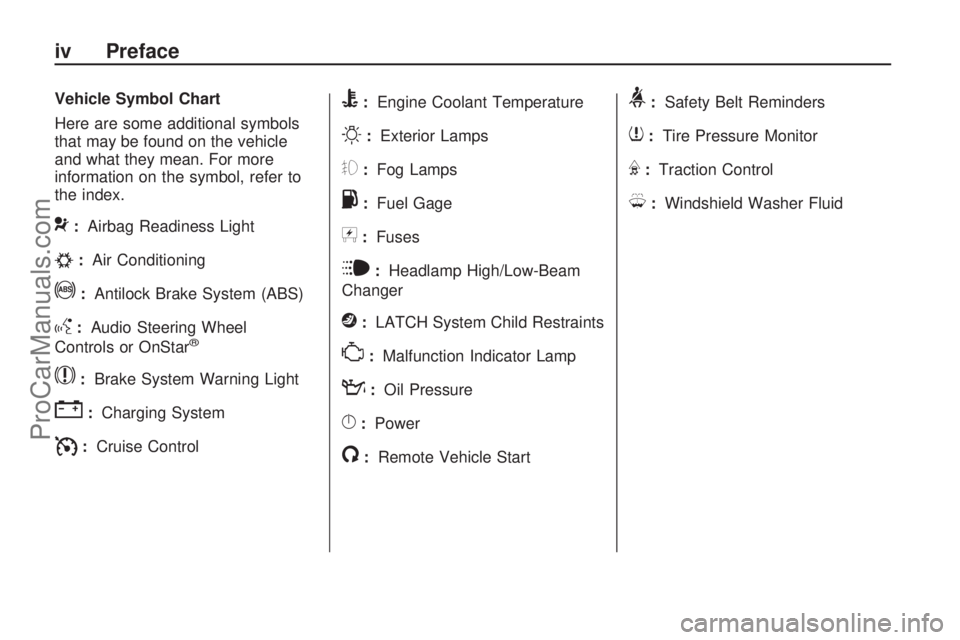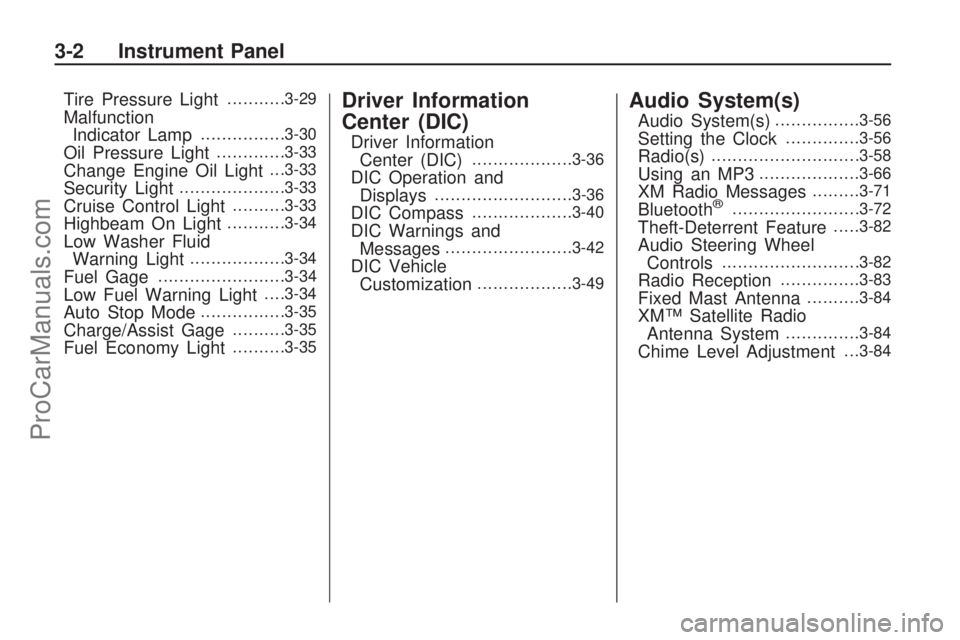fuel SATURN VUE HYBRID 2009 Owners Manual
[x] Cancel search | Manufacturer: SATURN, Model Year: 2009, Model line: VUE HYBRID, Model: SATURN VUE HYBRID 2009Pages: 346, PDF Size: 2.1 MB
Page 1 of 346

Seats and Restraint
System............................... 1-1
Head Restraints
.............. 1-2
Front Seats
.................... 1-3
Rear Seats
.................... 1-9
Safety Belts
..................1-10
Child Restraints
.............1-22
Airbag System
..............1-41
Restraint System
Check
......................1-56
Features and Controls...... 2-1
Keys
............................. 2-2
Doors and Locks
............ 2-6
Windows
........................ 2-9
Theft-Deterrent
Systems
...................2-10
Starting and Operating
Your Vehicle
.............2-14
Mirrors
.........................2-27
OnStar
®System
............2-29
Universal Home Remote
System
.....................2-32
Storage Areas
...............2-37
Instrument Panel............... 3-1
Instrument Panel
Overview
.................... 3-4
Climate Controls
............3-17
Warning Lights, Gages,
and Indicators
............3-22
Driver Information
Center (DIC)
.............3-36
Audio System(s)
............3-56
Driving Your Vehicle......... 4-1
Your Driving, the Road,
and the Vehicle
........... 4-1
Towing
........................4-22
Service and
Appearance Care............... 5-1
Service
.......................... 5-3
Fuel
.............................. 5-5
Checking Things Under
the Hood
.................... 5-9
Headlamp Aiming
..........5-33
Bulb Replacement
.........5-35Windshield Wiper Blade
Replacement
.............5-38
Tires
...........................5-38
Appearance Care
..........5-66
Vehicle Identi�cation
......5-74
Electrical System
...........5-74
Capacities and
Speci�cations
............5-81
Maintenance Schedule...... 6-1
Maintenance Schedule
..... 6-1
Customer Assistance
Information........................ 7-1
Customer Assistance and
Information
................. 7-1
Reporting Safety
Defects
.....................7-12
Vehicle Data Recording
and Privacy
...............7-14
Index....................................i-1
2009 Saturn VUE Green Line Hybrid Owner ManualM
ProCarManuals.com
Page 4 of 346

Vehicle Symbol Chart
Here are some additional symbols
that may be found on the vehicle
and what they mean. For more
information on the symbol, refer to
the index.
9:Airbag Readiness Light
#:Air Conditioning
!:Antilock Brake System (ABS)
g:Audio Steering Wheel
Controls or OnStar®
$:Brake System Warning Light
":Charging System
I:Cruise Control
B:Engine Coolant Temperature
O:Exterior Lamps
#:Fog Lamps
.:Fuel Gage
+:Fuses
i:Headlamp High/Low-Beam
Changer
j:LATCH System Child Restraints
*:Malfunction Indicator Lamp
::Oil Pressure
}:Power
/:Remote Vehicle Start
>:Safety Belt Reminders
7:Tire Pressure Monitor
F:Traction Control
M:Windshield Washer Fluid
iv Preface
ProCarManuals.com
Page 80 of 346

The Engine Will Remain
Running When:
The engine, transmission, or
hybrid battery is not warmed
up yet.
The outside temperature is
high — usually above
95°F (35°C) and the climate
control system is working to
cool the vehicle in A/C mode
(yellow light illuminated on
A/C button) or if defrost is
selected. SeeAutomatic Climate
Control System on page 3-17
for more information.
The shift lever is in P (Park),
R (Reverse), N (Neutral) or
M (Manual Mode).
The hybrid battery pack
charge is low.
The 12V vehicle battery charge
is low, or loads are high.
The hood is not fully closed.The Engine Will Restart When:
The brake pedal is released.
The accelerator pedal is applied.
When shifting from D (Drive)
to P (Park), R (Reverse),
N (Neutral) or M (Manual Mode),
the engine will restart
immediately.
If the A/C button (green light
illuminated on A/C) button is
selected, the duration of
the AUTO STOP will depend on
the outside temperature. This
economy mode improves
fuel economy by limiting the
effects of the air conditioning.
The warmer it is outside,
the shorter the time before the
engine is restarted to provide
cabin cooling.
The climate control system is
turned from Off to On (econ
or normal A/C, or �oor/
defog/defrost) SeeAutomatic
Climate Control System on
page 3-17for more information.
The engine is required to run for
either heater or climate control
performance. See “Air
Conditioning and Engine
Start/Stop” underAutomatic
Climate Control System on
page 3-17for more information.
The hybrid battery pack charge is
low and requires recharging.
Auto Stop time is greater than
two minutes.
2-18 Features and Controls
ProCarManuals.com
Page 81 of 346

Engine Coolant Heater
The engine coolant heater can
provide easier starting and better
fuel economy during engine
warm-up in cold weather conditions
at or below 0°F (−18°C). Vehicles
with an engine coolant heater should
be plugged in at least four hours
before starting. Some models
may have an internal thermostat
in the cord which will prevent engine
coolant heater operation at
temperatures above 0°F (−18°C).
To Use the Engine Coolant
Heater
1. Turn off the engine.
2. Open the hood and unwrap the
electrical cord. The engine
coolant heater cord is located
near the air cleaner box on
the passenger side of the engine
compartment. SeeEngine
Compartment Overview on
page 5-10for more information
on location.
3. Plug the cord into a normal,
grounded 110-volt AC outlet.
{CAUTION
Plugging the cord into an
ungrounded outlet could cause an
electrical shock. Also, the wrong
kind of extension cord could
overheat and cause a �re. You
could be seriously injured. Plug
the cord into a properly grounded
three-prong 110-volt AC outlet.
If the cord will not reach, use a
heavy-duty three-prong extension
cord rated for at least 15 amps.
4. Before starting the engine, be
sure to unplug and store the
cord as it was before to keep
it away from moving engine
parts. If you do not, it could be
damaged.
The length of time the heater should
remain plugged in depends on
several factors. Ask a dealer/retailer
in the area where you will be
parking the vehicle for the best
advice on this.
Features and Controls 2-19
ProCarManuals.com
Page 83 of 346

N (Neutral):In this position, the
engine does not connect with
the wheels. To restart the engine
when the vehicle is already moving,
use N (Neutral) only. Also, use
N (Neutral) when your vehicle is
being towed.
{CAUTION
Shifting into a drive gear while the
engine is running at high speed is
dangerous. Unless your foot is
�rmly on the brake pedal, the
vehicle could move very rapidly.
You could lose control and hit
people or objects. Do not shift into
a drive gear while the engine is
running at high speed.Notice:Shifting out of P (Park)
or N (Neutral) with the engine
running at high speed may
damage the transmission. The
repairs would not be covered by
the vehicle warranty. Be sure
the engine is not running at high
speed when shifting the vehicle.
D (Drive):This position is for normal
driving with the automatic
transmission. It provides the best
fuel economy. If you need more
power for passing, and you are:
Going less than about 35 mph
(55 km/h), push the accelerator
pedal about halfway down.
Going about 35 mph (55 km/h),
push the accelerator all the
way down.Downshifting the transmission in
slippery road conditions could result
in skidding, see “Skidding” under
Loss of Control on page 4-11.
M (Manual Mode):This position
allows you to change gears similar
to a manual transmission. If the
vehicle has this feature, see Manual
Shift Mode.
Notice:Spinning the tires or
holding the vehicle in one place
on a hill using only the
accelerator pedal may damage
the transmission. The repair
will not be covered by the vehicle
warranty. If you are stuck, do
not spin the tires. When stopping
on a hill, use the brakes to
hold the vehicle in place.
Features and Controls 2-21
ProCarManuals.com
Page 85 of 346

To release the parking brake, hold
the brake pedal down. Pull the
parking brake lever up until you can
press the release button. Hold
the release button in as you move
the brake lever all the way down.
Release the parking brake
before driving the vehicle.
Notice:Driving with the parking
brake on can overheat the
brake system and cause
premature wear or damage to
brake system parts. Make
sure that the parking brake is
fully released and the brake
warning light is off before driving.Regenerative Braking
Regenerative braking takes some of
the energy from the moving
vehicle and turns it back into
electrical energy. This energy is
then stored back into the vehicle’s
hybrid battery system, contributing
to increased fuel efficiency.
The system works whenever you
take your foot off the accelerator
pedal while the vehicle is moving in a
forward gear. This causes the
vehicle to slow down more quickly. It
may feel like the brake pedal is being
pressed, even when it is not.
Shifting Into Park
{CAUTION
It can be dangerous to get out of
the vehicle if the shift lever is not
fully in P (Park) with the parking
brake �rmly set. The vehicle can
roll. If you have left the engine
running, the vehicle can move
suddenly. You or others could be
injured. To be sure the vehicle will
not move, even when you are on
fairly level ground, use the steps
that follow. If you are pulling a
trailer, seeTowing a Trailer on
page 4-26.
1. Hold the brake pedal down and
set the parking brake. See
Parking Brake on page 2-22for
more information.
2. Move the shift lever into P (Park)
by pressing the button on the
shift lever and pushing the lever
all the way toward the front of
the vehicle.
Features and Controls 2-23
ProCarManuals.com
Page 104 of 346

Tire Pressure Light...........3-29
Malfunction
Indicator Lamp................3-30
Oil Pressure Light.............3-33
Change Engine Oil Light. . .3-33
Security Light....................3-33
Cruise Control Light..........3-33
Highbeam On Light...........3-34
Low Washer Fluid
Warning Light..................3-34
Fuel Gage........................3-34
Low Fuel Warning Light. . . .3-34
Auto Stop Mode................3-35
Charge/Assist Gage..........3-35
Fuel Economy Light..........3-35
Driver Information
Center (DIC)
Driver Information
Center (DIC)...................3-36
DIC Operation and
Displays..........................3-36
DIC Compass...................3-40
DIC Warnings and
Messages........................3-42
DIC Vehicle
Customization..................3-49
Audio System(s)
Audio System(s)................3-56
Setting the Clock..............3-56
Radio(s)............................3-58
Using an MP3...................3-66
XM Radio Messages.........3-71
Bluetooth®........................3-72
Theft-Deterrent Feature.....3-82
Audio Steering Wheel
Controls..........................3-82
Radio Reception...............3-83
Fixed Mast Antenna..........3-84
XM™ Satellite Radio
Antenna System..............3-84
Chime Level Adjustment. . .3-84
3-2 Instrument Panel
ProCarManuals.com
Page 119 of 346

Climate Controls
Automatic Climate Control System
The heating, cooling, and ventilation for the vehicle can be controlled with
this system.
A. Fan Control
B. Temperature Control
C. Air Delivery Mode Control
D. Normal Air ConditioningE. Hybrid Air Conditioning
F. Recirculation
G. Rear Window DefoggerClimate Control In�uence on
Hybrid Operation and Fuel
Economy
To maximize your fuel economy, use
the following settings (as indicated
by the green marking):
Set the fan knob to AUTO.
Set the air delivery knob
to AUTO.
Select an air temperature setting
near 75°F (23°C).
Select the Hybrid A/C button, if
A/C is required.
Avoid using these settings that may
lead to fewer auto stops and to
higher fuel consumption:
Manual fan speed operation.
Defrost mode. Only use this
setting to clear the windows.
Extreme cold or hot air
temperature settings, such as
60°F (16°C) or 90°F (32°C).
Normal air conditioning mode, if
A/C is required.
Instrument Panel 3-17
ProCarManuals.com
Page 120 of 346

Automatic Operation
This climate control system
automatically maintains the desired
temperature inside the vehicle.
Do not cover the sensor located on
the top of the instrument panel
near the windshield or the sensor
grille below the climate control
faceplate. These two sensors help
regulate the inside air temperature.
AUTO (Automatic Fan):Turn
the fan knob to AUTO for the system
to automatically adjust the fan
speed to reach the desired inside
temperature.
Temperature Control:Select the
desired air temperature between
60-90°F (16-32°C). Typically,
the best setting is near 75°F (23°C).
Choosing the coldest or warmest
temperature setting does not cause
the system to heat or cool any
faster.AUTO (Automatic Air Delivery
Mode):Turn the air delivery mode
knob to AUTO for the system to
automatically control the direction of
the air�ow to help reach the
desired inside temperature.
The system automatically controls
the air inlet to supply the outside air
or recirculated inside air needed
to cool the vehicle faster. The
indicator light on the recirculation
button will be lit whenever the
system changes to recirculation.
Press the recirculation button
to change to outside air. However,
the recirculation mode may turn
back on automatically.
In cold weather, if the fan and air
delivery modes are in automatic, the
system starts at lower fan speeds
to avoid directing cold air into
the vehicle until warmer air is
available. The climate control
system directs air to the �oor, but
may automatically change modes as
the vehicle warms up to maintain
the chosen temperature setting.The length of time needed to warm
the interior depends on the
outside temperature and inside
temperature of the vehicle.
Manual Operation
It is best to use the automatic
settings to maximize fuel economy.
A(Fan Control):Turn clockwise
or counterclockwise to increase
or decrease the fan speed. To turn
the fan off, turn the left knob to
the
9position. In any setting other
than off, the fan runs continuously
with the ignition on. The fan must be
turned on to run the air conditioning
compressor. There will be some
air�ow noticeable from the various
outlets when driving, even with
the fan in the off position. This is to
ensure some fresh air is always
available in the vehicle. To turn off
the air completely, turn the fan
to
9and select the recirculation
button.
3-18 Instrument Panel
ProCarManuals.com
Page 122 of 346

#(Normal Air Conditioning):
Press to turn the air conditioning
system on or off. An indicator
light comes on to show that the air
conditioning is on. Normal Air
Conditioning (A/C) can be selected
in any mode as long as the fan
is on and the outside air temperature
is above freezing. Normal A/C
cannot be selected at the same time
as Hybrid Air Conditioning (A/C).
A �ashing indicator light indicates
that the air conditioning compressor
is currently not available.
When Normal A/C is selected, the
climate control system prevents
all automatic engine start/stop
operations. This will ensure the
cabin comfort is maintained.
See “Air Conditioning and Automatic
Engine Start/Stop” later in this
section.
N(Hybrid Air Conditioning):
Press to turn the Hybrid A/C system
on or off. An indicator light comes
on to show that Hybrid A/C is
on. Hybrid A/C can be selected inany mode, except defrost as long as
the fan is on and the outside air
temperature is above freezing.
Hybrid A/C cannot be selected at
the same time as the normal
air conditioning. A �ashing indicator
light shows the air conditioning
compressor is not available.
The Hybrid A/C works to balance
fuel economy and air conditioning
comfort. When Hybrid A/C is used in
warm weather, the vehicle gets
better fuel economy by allowing
more frequent start/stops. For
additional cooling, select Normal
A/C. See “Air Conditioning and
Automatic Engine Start/Stop” later in
this section.
@(Recirculation):Press to
toggle between the recirculation and
outside air modes. The indicator
light turns on when the recirculation
mode is selected. This mode can
be used to prevent outside air
and odors from entering the vehicle
or to help cool the air inside the
vehicle more quickly. Avoid usingthe recirculation mode during high
periods of humidity and cool outside
temperatures since this may
result in increased window fogging.
If window fogging is experienced,
select the defrost mode.
Recirculation mode is not available
in �oor, defog or defrost modes.
If the button is selected in
these modes, the indicator will �ash.
This helps prevent window fogging
and moisture building up inside
the vehicle.
Rear Window Defogger
The rear window defogger uses a
warming grid to remove fog from the
rear window.
The rear window defogger will only
work when the ignition is in
ON/RUN.
<(Rear Window Defogger):
Press to turn the rear window
defogger on or off. An indicator light
on the button comes on to show
that it is activated.
3-20 Instrument Panel
ProCarManuals.com